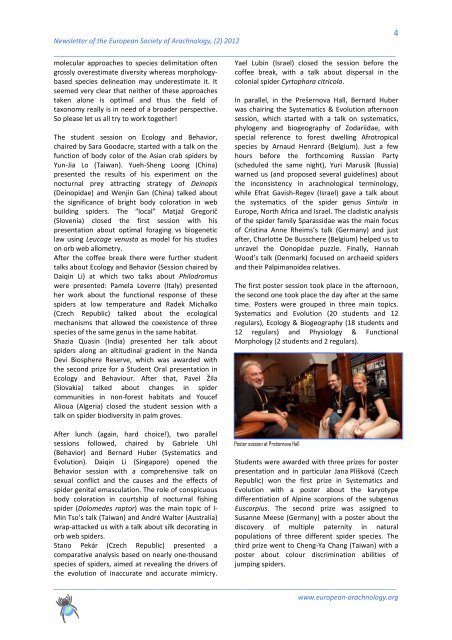Newsletter 2 - European Society of Arachnology
Newsletter 2 - European Society of Arachnology
Newsletter 2 - European Society of Arachnology
Create successful ePaper yourself
Turn your PDF publications into a flip-book with our unique Google optimized e-Paper software.
<strong>Newsletter</strong> <strong>of</strong> the <strong>European</strong> <strong>Society</strong> <strong>of</strong> <strong>Arachnology</strong>, (2) 2012<br />
___________________________________________________________________________<br />
molecular approaches to species delimitation <strong>of</strong>ten<br />
grossly overestimate diversity whereas morphologybased<br />
species delineation may underestimate it. It<br />
seemed very clear that neither <strong>of</strong> these approaches<br />
taken alone is optimal and thus the field <strong>of</strong><br />
taxonomy really is in need <strong>of</strong> a broader perspective.<br />
So please let us all try to work together!<br />
The student session on Ecology and Behavior,<br />
chaired by Sara Goodacre, started with a talk on the<br />
function <strong>of</strong> body color <strong>of</strong> the Asian crab spiders by<br />
Yun-Jia Lo (Taiwan). Yueh-Sheng Loong (China)<br />
presented the results <strong>of</strong> his experiment on the<br />
nocturnal prey attracting strategy <strong>of</strong> Deinopis<br />
(Deinopidae) and Wenjin Gan (China) talked about<br />
the significance <strong>of</strong> bright body coloration in web<br />
building spiders. The “local” Matjaž Gregorič<br />
(Slovenia) closed the first session with his<br />
presentation about optimal foraging vs biogenetic<br />
law using Leucage venusta as model for his studies<br />
on orb web allometry.<br />
After the c<strong>of</strong>fee break there were further student<br />
talks about Ecology and Behavior (Session chaired by<br />
Daiqin Li) at which two talks about Philodromus<br />
were presented: Pamela Loverre (Italy) presented<br />
her work about the functional response <strong>of</strong> these<br />
spiders at low temperature and Radek Michalko<br />
(Czech Republic) talked about the ecological<br />
mechanisms that allowed the coexistence <strong>of</strong> three<br />
species <strong>of</strong> the same genus in the same habitat.<br />
Shazia Quasin (India) presented her talk about<br />
spiders along an altitudinal gradient in the Nanda<br />
Devi Biosphere Reserve, which was awarded with<br />
the second prize for a Student Oral presentation in<br />
Ecology and Behaviour. After that, Pavel Žila<br />
(Slovakia) talked about changes in spider<br />
communities in non-forest habitats and Youcef<br />
Alioua (Algeria) closed the student session with a<br />
talk on spider biodiversity in palm groves.<br />
After lunch (again, hard choice!), two parallel<br />
sessions followed, chaired by Gabriele Uhl<br />
(Behavior) and Bernard Huber (Systematics and<br />
Evolution). Daiqin Li (Singapore) opened the<br />
Behavior session with a comprehensive talk on<br />
sexual conflict and the causes and the effects <strong>of</strong><br />
spider genital emasculation. The role <strong>of</strong> conspicuous<br />
body coloration in courtship <strong>of</strong> nocturnal fishing<br />
spider (Dolomedes raptor) was the main topic <strong>of</strong> I-<br />
Min Tso’s talk (Taiwan) and André Walter (Australia)<br />
wrap-attacked us with a talk about silk decorating in<br />
orb web spiders.<br />
Stano Pekár (Czech Republic) presented a<br />
comparative analysis based on nearly one-thousand<br />
species <strong>of</strong> spiders, aimed at revealing the drivers <strong>of</strong><br />
the evolution <strong>of</strong> inaccurate and accurate mimicry.<br />
Yael Lubin (Israel) closed the session before the<br />
c<strong>of</strong>fee break, with a talk about dispersal in the<br />
colonial spider Cyrtophora citricola.<br />
In parallel, in the Prešernova Hall, Bernard Huber<br />
was chairing the Systematics & Evolution afternoon<br />
session, which started with a talk on systematics,<br />
phylogeny and biogeography <strong>of</strong> Zodariidae, with<br />
special reference to forest dwelling Afrotropical<br />
species by Arnaud Henrard (Belgium). Just a few<br />
hours before the forthcoming Russian Party<br />
(scheduled the same night), Yuri Marusik (Russia)<br />
warned us (and proposed several guidelines) about<br />
the inconsistency in arachnological terminology,<br />
while Efrat Gavish-Regev (Israel) gave a talk about<br />
the systematics <strong>of</strong> the spider genus Sintula in<br />
Europe, North Africa and Israel. The cladistic analysis<br />
<strong>of</strong> the spider family Sparassidae was the main focus<br />
<strong>of</strong> Cristina Anne Rheims’s talk (Germany) and just<br />
after, Charlotte De Busschere (Belgium) helped us to<br />
unravel the Oonopidae puzzle. Finally, Hannah<br />
Wood’s talk (Denmark) focused on archaeid spiders<br />
and their Palpimanoidea relatives.<br />
The first poster session took place in the afternoon,<br />
the second one took place the day after at the same<br />
time. Posters were grouped in three main topics.<br />
Systematics and Evolution (20 students and 12<br />
regulars), Ecology & Biogeography (18 students and<br />
12 regulars) and Physiology & Functional<br />
Morphology (2 students and 2 regulars).<br />
Poster session at Prešernova Hall<br />
Students were awarded with three prizes for poster<br />
presentation and in particular Jana Plíšková (Czech<br />
Republic) won the first prize in Systematics and<br />
Evolution with a poster about the karyotype<br />
differentiation <strong>of</strong> Alpine scorpions <strong>of</strong> the subgenus<br />
Euscorpius. The second prize was assigned to<br />
Susanne Meese (Germany) with a poster about the<br />
discovery <strong>of</strong> multiple paternity in natural<br />
populations <strong>of</strong> three different spider species. The<br />
third prize went to Cheng-Ya Chang (Taiwan) with a<br />
poster about colour discrimination abilities <strong>of</strong><br />
jumping spiders.<br />
_______________________________________________________________________<br />
www.european-arachnology.org<br />
4
















